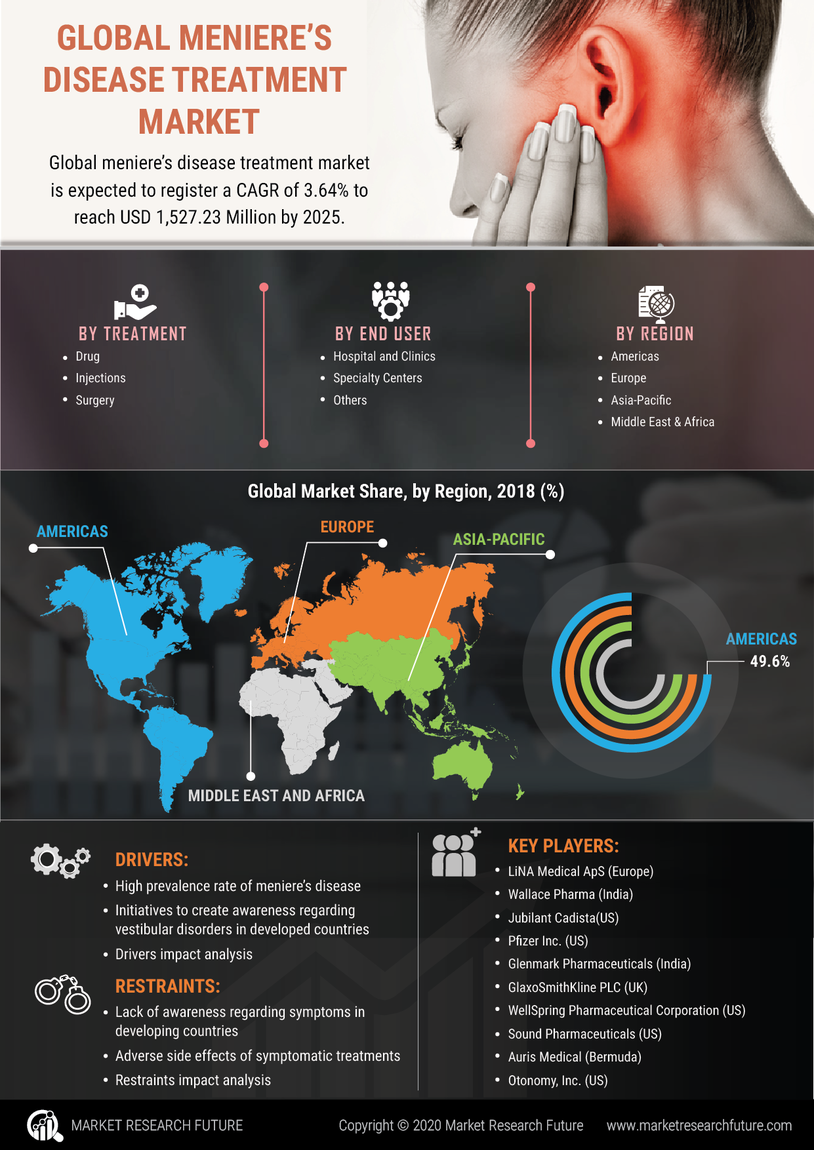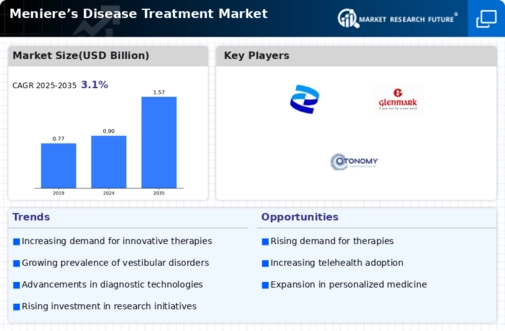Aging Population
The demographic shift towards an aging population is a significant factor impacting the Global Meniere’s Disease Treatment Market Industry. Older adults are more susceptible to developing Meniere's disease due to age-related changes in the inner ear. As the global population aged 65 and older continues to rise, the demand for effective treatment options is expected to increase correspondingly. This trend suggests a robust market growth trajectory, with projections indicating a compound annual growth rate (CAGR) of 5.2% from 2025 to 2035. The aging demographic not only amplifies the prevalence of the disease but also drives the need for specialized care and treatment solutions.
Market Growth Projections
The Global Meniere’s Disease Treatment Market Industry is projected to experience substantial growth over the coming years. With an estimated market value of 0.9 USD Billion in 2024, it is anticipated to reach 1.57 USD Billion by 2035, reflecting a compound annual growth rate (CAGR) of 5.2% from 2025 to 2035. This growth is driven by various factors, including advancements in treatment technologies, increased awareness, and an aging population. The market dynamics suggest a robust expansion, indicating a promising future for stakeholders involved in the treatment of Meniere's disease.
Increased Awareness and Education
The growing awareness and education regarding Meniere's disease among healthcare professionals and the general public play a crucial role in shaping the Global Meniere’s Disease Treatment Market Industry. Campaigns aimed at educating patients about the symptoms and treatment options available are likely to lead to earlier diagnosis and intervention. This heightened awareness can potentially increase the number of individuals seeking treatment, thereby expanding the market. As healthcare providers become more knowledgeable about the disease, they may also be more inclined to recommend advanced treatment options, contributing to the overall growth of the market.
Government Initiatives and Funding
Government initiatives aimed at improving healthcare access and funding for research into Meniere's disease are likely to bolster the Global Meniere’s Disease Treatment Market Industry. Increased funding for clinical trials and research programs can lead to the development of new therapies and treatment protocols. Additionally, policies that enhance healthcare access for patients with Meniere's disease can facilitate timely diagnosis and treatment. Such initiatives may contribute to a more favorable market environment, encouraging innovation and investment in the sector, ultimately supporting the growth of the market.
Advancements in Treatment Technologies
Technological innovations in the treatment of Meniere's disease are significantly influencing the Global Meniere’s Disease Treatment Market Industry. New therapies, including intratympanic injections and minimally invasive surgical options, are emerging, providing patients with more effective and less invasive alternatives. These advancements not only improve patient outcomes but also attract investment in research and development. As a result, the market is expected to grow, reaching an estimated value of 1.57 USD Billion by 2035. The integration of technology in treatment options may also enhance patient adherence and satisfaction, further driving market demand.
Rising Prevalence of Meniere's Disease
The increasing incidence of Meniere's disease globally is a primary driver for the Global Meniere’s Disease Treatment Market Industry. As more individuals are diagnosed with this condition, the demand for effective treatment options rises. Current estimates suggest that approximately 0.2% of the population is affected by Meniere's disease, leading to a projected market value of 0.9 USD Billion in 2024. This growing patient population necessitates advancements in treatment modalities, thereby propelling market growth. Furthermore, the awareness surrounding this disease is likely to enhance diagnosis rates, contributing to the overall expansion of the market.

















Leave a Comment